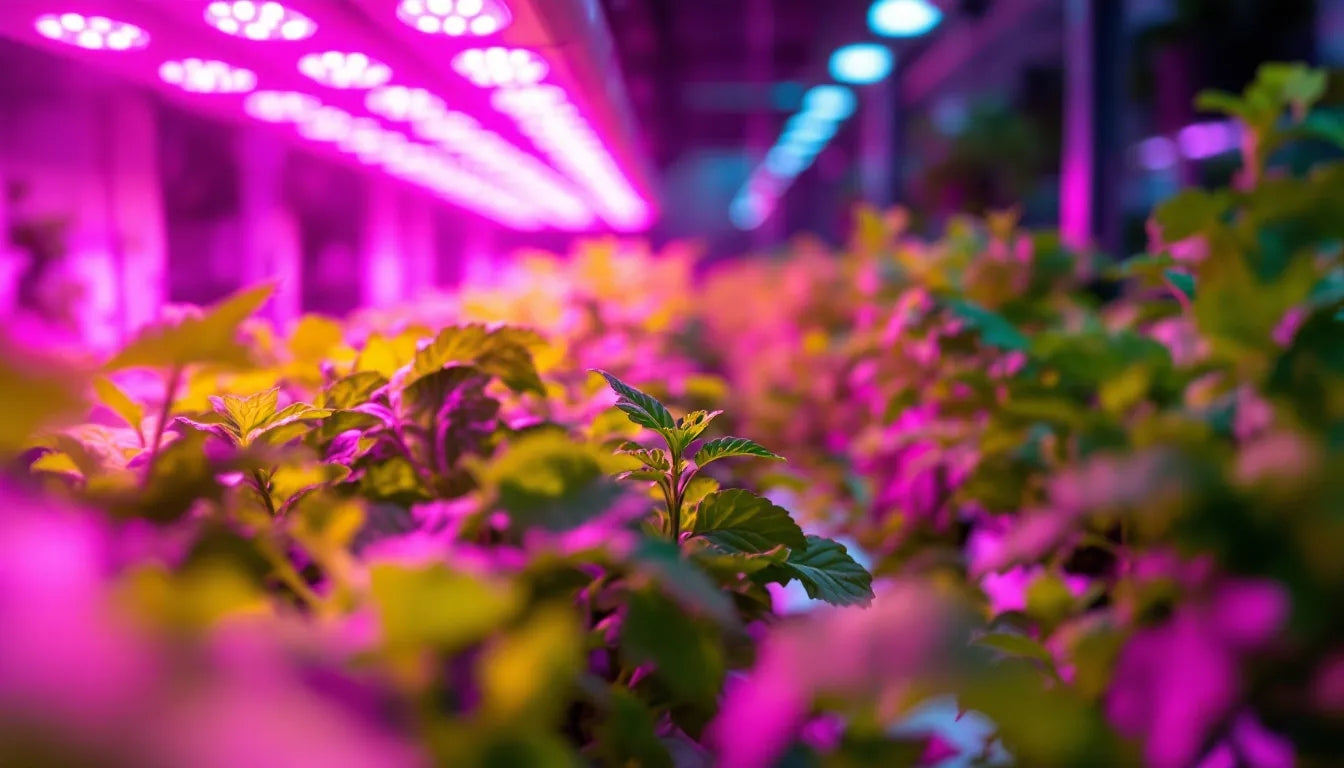
UV Light for Plants: Complete Guide to Enhanced Indoor Growing
Understanding UV Light and Its Role in Plant Development
UV light for plants has become a revolutionary component in modern indoor gardening, transforming how growers achieve maximum yields and superior plant quality. Ultraviolet light, existing beyond the visible spectrum, plays a crucial role in plant development that many indoor gardeners overlook. While plants can survive without UV exposure, incorporating controlled amounts of UVA and UVB light can dramatically enhance plant health, potency, and overall quality.

The science behind UV light for plants centers on how these specific wavelengths trigger natural defense mechanisms and enhance secondary metabolite production. When plants receive appropriate UV exposure, they develop stronger cell walls, produce more protective compounds, and exhibit increased resistance to environmental stressors.
Types of UV Light: UVA, UVB, and UVC Explained
Understanding the different types of UV light is essential for successful indoor growing. UV light is categorized into three distinct types, each with different effects on plant development:
UVA Light (315-400 nm)
UVA represents the least harmful type of UV light and is commonly integrated into advanced grow light systems. This wavelength promotes plant development and enhances flavor, color, and overall quality of fruits and flowers. UVA light helps stimulate photomorphogenesis, which is the developmental response of plants to light exposure.
UVB Light (280-315 nm)
UVB light plays a more intense but equally important role in plant development. This wavelength stimulates plant defense mechanisms and increases the production of beneficial compounds such as antioxidants, terpenes, and essential oils. UVB exposure encourages plants to produce secondary metabolites that significantly improve plant quality and potency.
UVC Light (100-280 nm)
UVC light is harmful to all living organisms, including plants, and is typically filtered out by Earth's atmosphere. This wavelength is not used in grow lights due to its damaging effects and is not recommended for any indoor growing applications.
The Science Behind UV Light Benefits for Indoor Plants
UV light for plants triggers several biological processes that enhance growth, quality, and resistance. Research shows that controlled UV exposure stimulates the production of phytochromes and cryptochromes, proteins that regulate plant growth and development. This leads to faster growth rates, higher yields, and superior plant quality.
Enhanced Secondary Metabolite Production
When exposed to UV light, particularly UVB, plants increase their production of secondary metabolites including terpenes, flavonoids, and antioxidants. These compounds not only improve the flavor, aroma, and color of fruits and flowers but also increase the plant's nutritional value and therapeutic properties.
Strengthened Plant Defense Systems
UV light exposure encourages plants to build thicker cell walls and produce more protective compounds, making them more resistant to pests, diseases, and environmental stress. This enhanced resilience leads to healthier, more robust plants that can thrive even in challenging growing conditions.
Improved Nutrient Absorption
UV light enhances plants' ability to absorb nutrients, especially phosphorus, which is essential for plant growth. This improved nutrient uptake efficiency results in stronger, healthier plants with better overall development.
How UV Light Enhances Plant Quality and Yields
Integrating UV light into your grow setup can dramatically improve both the quantity and quality of your harvest. Plants exposed to appropriate UV levels demonstrate increased vigor, enhanced coloration, and improved aromatic compounds.
Increased Resin and Trichome Production
One of the most significant benefits of UV light, particularly UVB, is its ability to stimulate resin production in flowering plants. When exposed to UVB light, plants produce more resin as a natural defense mechanism, resulting in increased potency and higher-quality yields.
Enhanced Color, Flavor, and Aroma
UV light exposure increases the production of anthocyanins and other compounds that contribute to vibrant colors and rich tastes in plants. The enhanced production of these compounds results in more flavorful and visually appealing produce.
Structural Improvements
UV light encourages plants to strengthen their cell walls and develop more robust structures. This is particularly beneficial for plants that need to support large fruits or flowers, resulting in stronger stems and improved overall plant architecture.
Professional UV LED Grow Light Solutions
Modern LED grow light technology has revolutionized how growers incorporate UV light into their indoor gardens. Professional-grade LED systems now include precisely controlled UV wavelengths that can be adjusted based on plant needs and growth stages.
Kind LED X Series: Advanced UV/IR Control
The Kind LED X420 grow light represents the pinnacle of UV light technology for indoor growing. This advanced system features programmable UV/IR control, allowing growers to customize UV exposure based on specific plant requirements and growth stages.
The X Series lights incorporate targeted full-spectrum technology that includes both UVA and UVB wavelengths. Since UV light is primarily needed during late flowering stages, these lights feature separately controlled UV channels, eliminating wasted energy and preventing unwanted stress during earlier growth phases.
Key Features of Professional UV LED Systems
- Programmable UV/IR control for precise light management
- Targeted full-spectrum technology optimized for plant growth
- Separate UV channels for stage-specific lighting
- Energy-efficient operation with minimal heat generation
- Professional-grade diodes for consistent performance
Implementing UV Light in Your Growing Setup
Successfully incorporating UV light for plants requires understanding proper timing, intensity, and duration. Unlike visible light spectrums that plants need throughout their lifecycle, UV light is most beneficial during specific growth stages.
Optimal UV Light Timing
UV light should primarily be used during the flowering stage when plants benefit most from increased resin production and enhanced secondary metabolite development. Starting UV exposure too early can cause unnecessary stress and potentially harm plant development.
Safety Considerations
When working with UV light systems, proper safety equipment is essential. UV radiation can be harmful to human skin and eyes, making protective eyewear and clothing necessary when working in grow spaces with active UV lights.
Integration with Full-Spectrum Systems
The most effective approach combines UV light with comprehensive full-spectrum LED systems. The Kind LED X750 grow light provides complete spectrum control, including precisely calibrated UV wavelengths that work synergistically with other light spectrums.
Maximizing Results with Controlled Environment Systems
UV light for plants works best when integrated into a controlled growing environment. Proper environmental management enhances the benefits of UV exposure while minimizing potential stress factors.
Temperature and Humidity Management
UV lights generate less heat than traditional lighting systems, making temperature control easier. Maintaining optimal temperature and humidity levels ensures plants can fully benefit from UV exposure without experiencing stress.
Air Circulation and Ventilation
Proper air movement helps distribute UV light evenly throughout the growing space while preventing hot spots that could damage sensitive plant tissues.
Growth Stage Optimization
Different growth stages require different UV intensities and durations. Seedlings and young plants should receive minimal UV exposure, while mature flowering plants benefit from increased UV intensity during specific periods.
Advanced UV Light Strategies for Commercial Growers
Commercial growing operations can leverage UV light technology to achieve superior results and competitive advantages. Professional-grade systems offer precise control and monitoring capabilities that maximize both quality and yield.
Spectrum Scheduling
Advanced LED systems allow growers to program specific UV schedules that align with natural light cycles and plant development phases. This precision timing optimizes plant responses while minimizing energy consumption.
Quality Enhancement Protocols
Commercial growers use UV light strategically to enhance specific plant characteristics such as potency, flavor profiles, and visual appeal. These targeted approaches can significantly increase product value and market competitiveness.
Integrated Growing Systems
The Kind LED X330 grow light demonstrates how UV technology integrates seamlessly with comprehensive growing systems, providing growers with complete control over their lighting environment.
Future of UV Light Technology in Indoor Growing
UV light technology continues advancing, offering even greater potential for indoor gardening and commercial cultivation. Researchers are exploring additional UV wavelengths and their effects on plant growth, potentially unlocking new possibilities for crop optimization and quality enhancement.
Emerging Applications
New research investigates UV light applications for disease prevention, pest control, and enhanced nutrient absorption. These developments promise to expand UV light benefits beyond current applications.
Technology Integration
Future UV light systems will likely integrate with smart growing platforms, providing automated control based on real-time plant monitoring and environmental conditions.
Conclusion: Transforming Indoor Growing with UV Light
UV light for plants represents a significant advancement in indoor growing technology, offering growers unprecedented control over plant quality and characteristics. By understanding UV light science and implementing professional-grade systems, growers can achieve superior results that were previously impossible with traditional lighting.
Whether you're a home gardener seeking to enhance your harvest quality or a commercial grower looking to gain competitive advantages, UV light technology provides the tools necessary for success. Modern LED systems like the Kind LED X Series make professional-grade UV control accessible to growers at every level, democratizing access to advanced growing techniques.
The future of indoor growing lies in precisely controlled environments that leverage every aspect of light science, and UV light technology represents a crucial component of this evolution. By incorporating UV light into your growing strategy, you're investing in technology that delivers measurable improvements in plant quality, potency, and overall harvest value.

Lena Myles
I'm a mushroom enthusiast and home cook based in Oregon. I'm passionate about foraging and creating fungi-focused recipes, especially delicious, plant-based dishes using gourmet mushrooms like trumpet, shiitake, and oyster. When I’m not in the kitchen, you’ll usually find me wandering the woods in search of new wild flavors.



